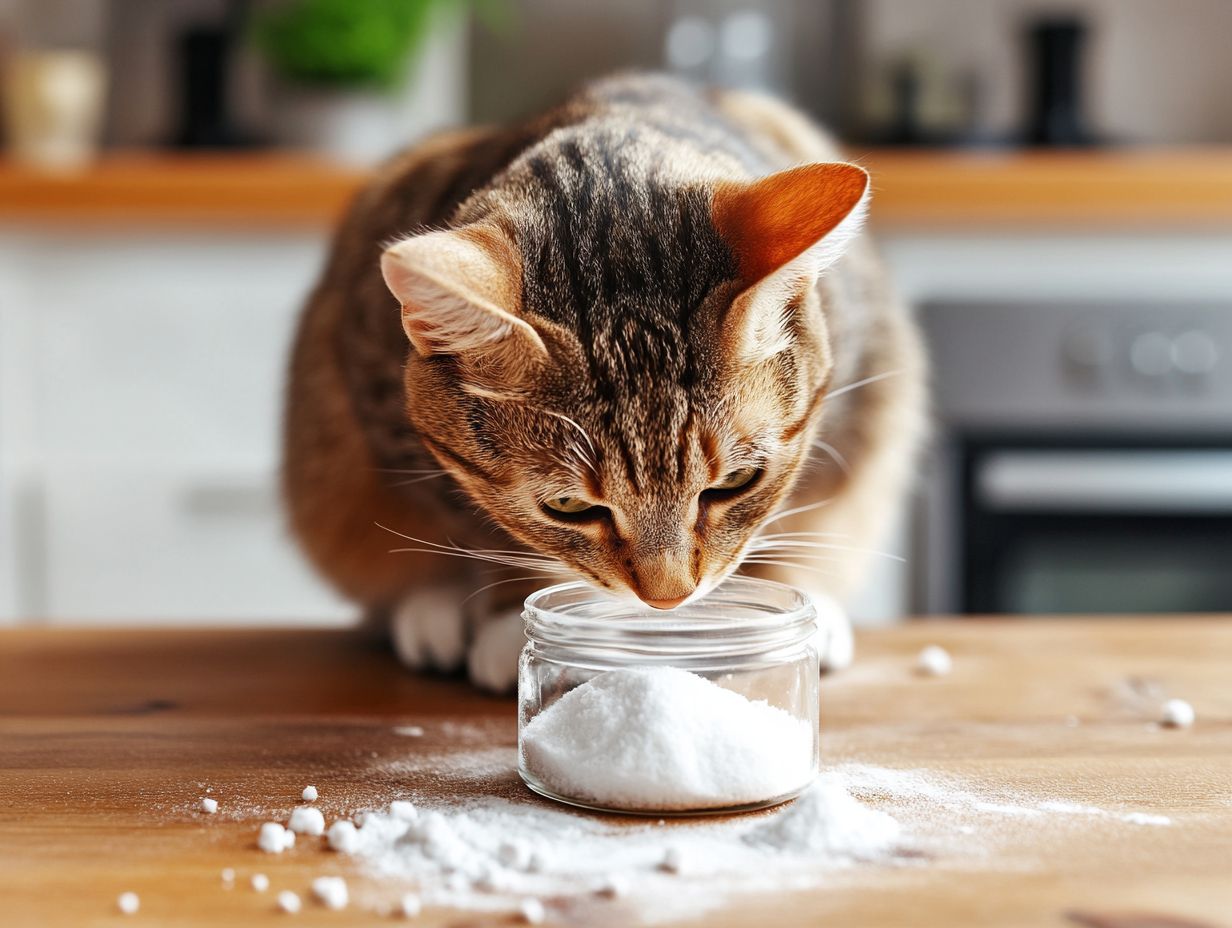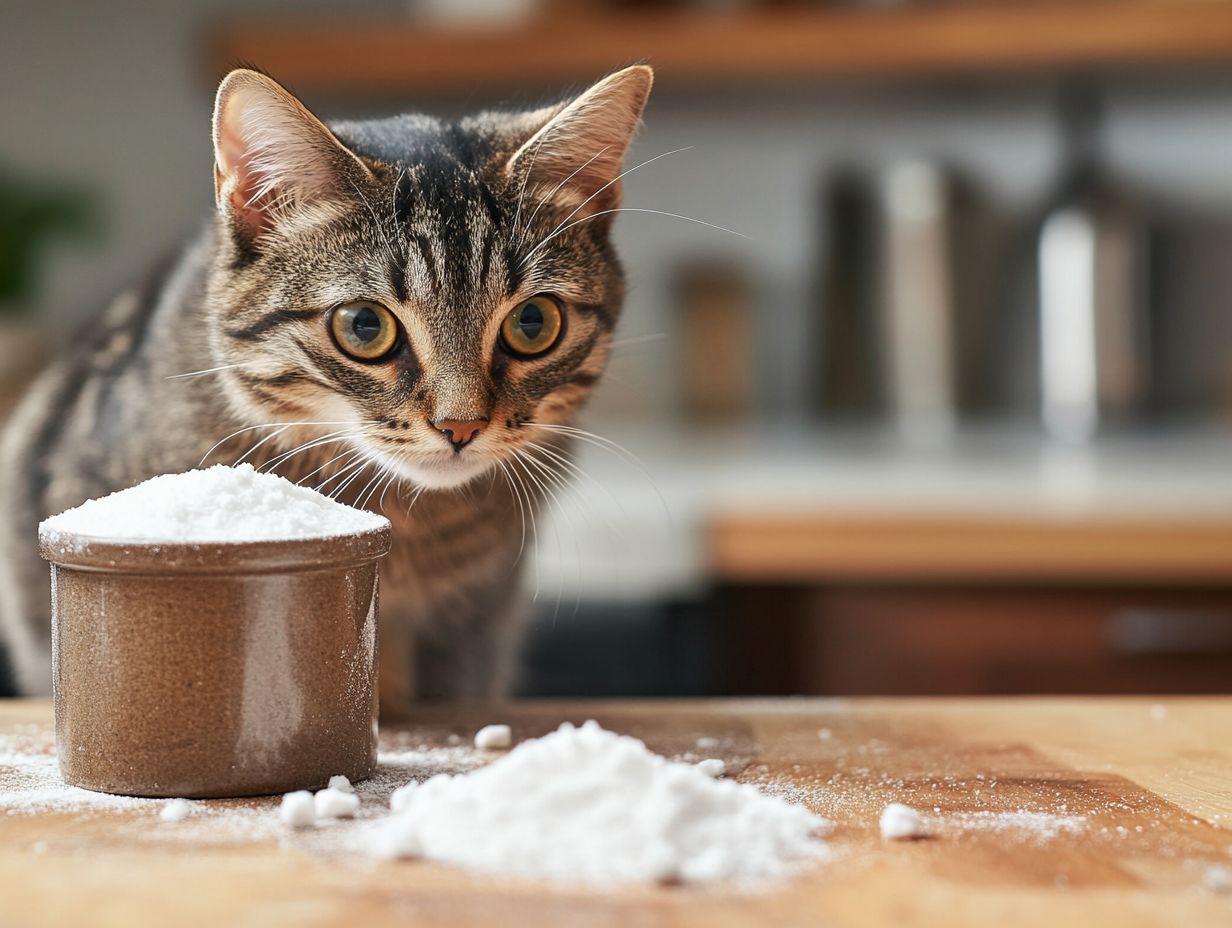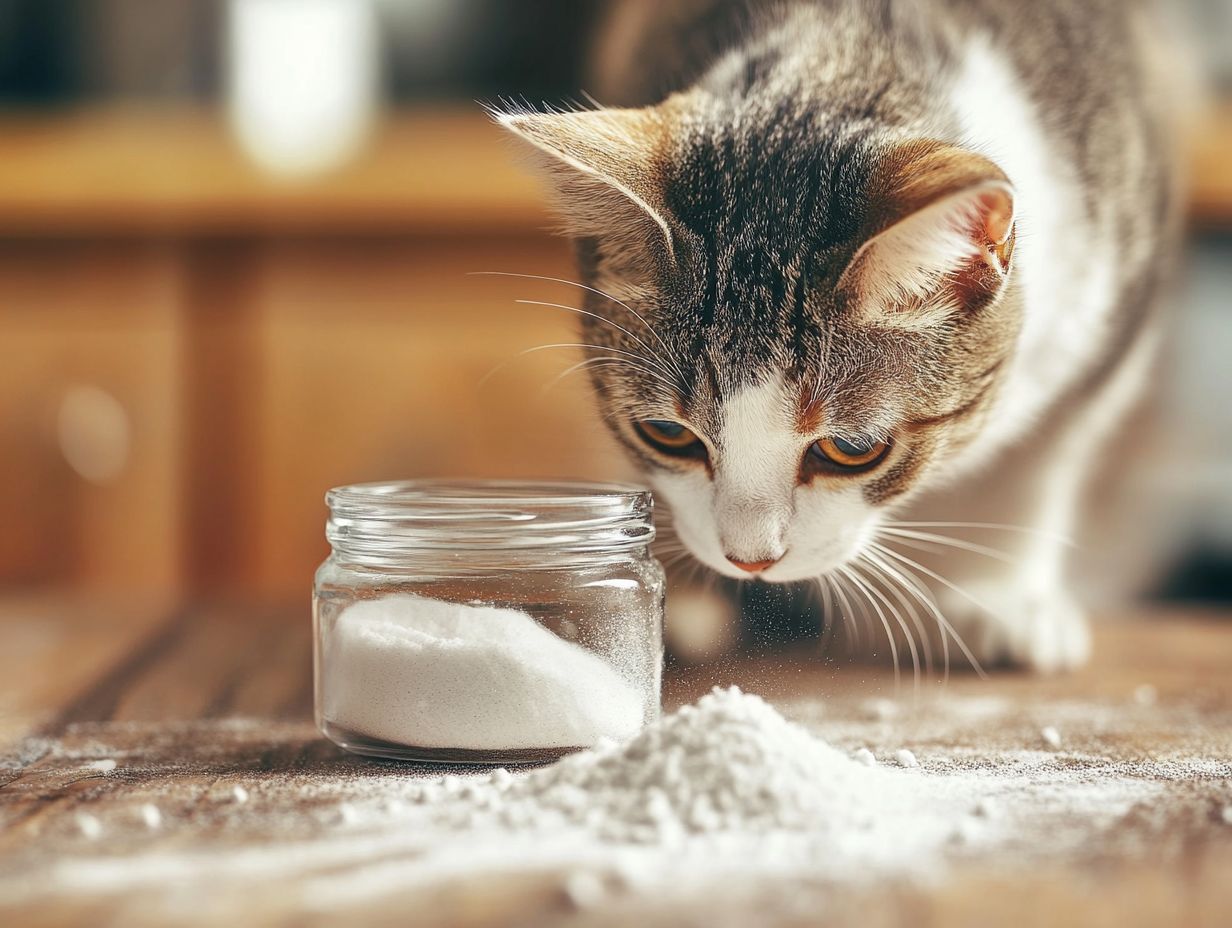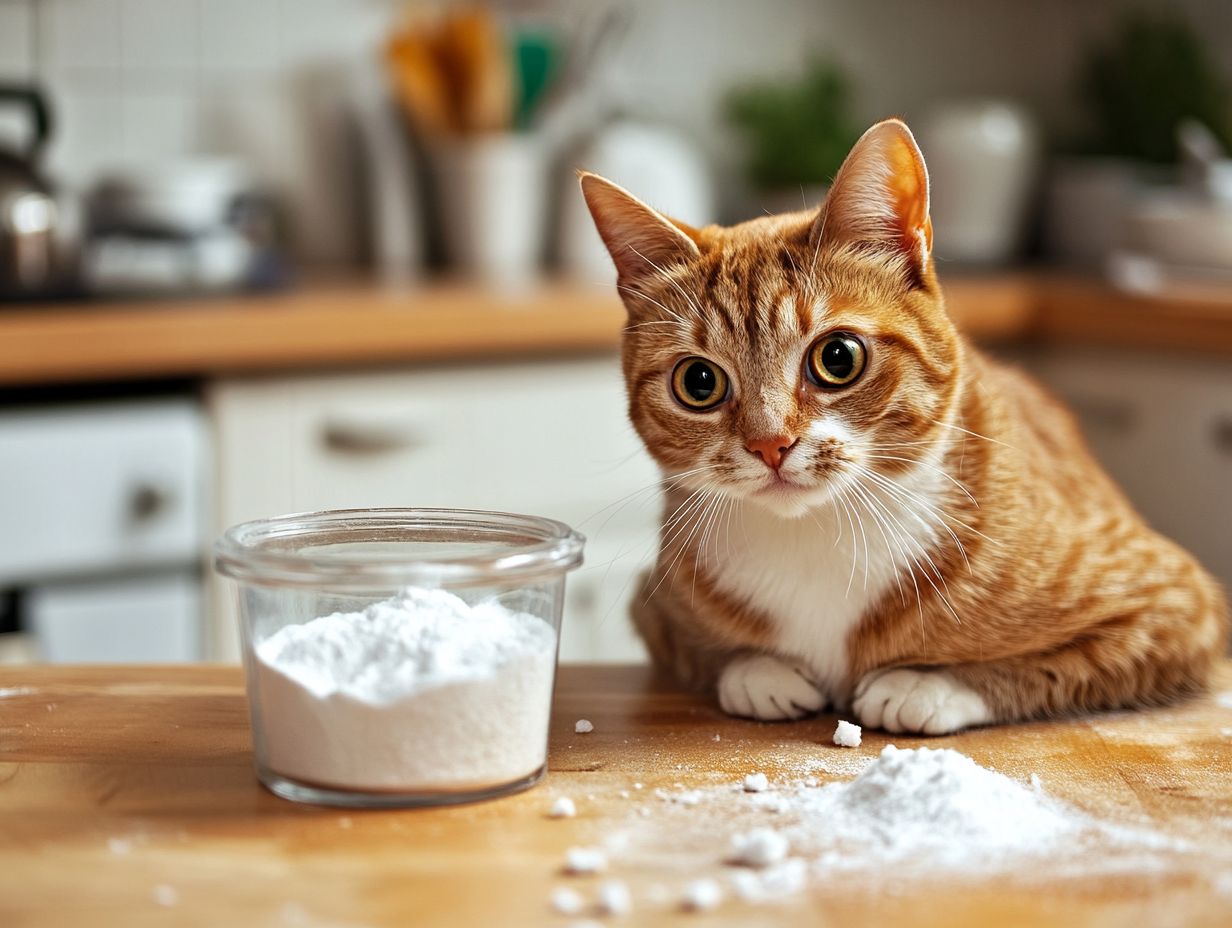Baking soda is considered mildly toxic to cats, primarily when ingested. Curious about whether baking soda or baking powder is safe for your feline friend? While they are common household items, many pet owners aren’t aware of the potential risks they pose to cats.
From digestive issues to respiratory problems, baking soda can lead to serious health concerns if ingested. This article explores the dangers of baking soda, signs of cat toxicity, and essential steps to take if your cat accidentally ingests it. Research from veterinary journals indicates that even small amounts can be harmful.
Additionally, we’ll offer safe alternatives to keep your home fresh, like deodorizing cat litter and cleaning solutions, without putting your pet at risk. Read on to ensure your cat’s safety!
Key Takeaways:

Is Baking Soda Safe for Cats?
Baking soda, also known as sodium bicarbonate, is a common household item with numerous uses. However, as a cat owner, you may be concerned about its safety for your feline companions.
While baking soda is an effective deodorizer and cleaning agent, it is important to weigh its benefits against potential risks to ensure your cat’s health and safety. Issues can arise if cats accidentally ingest the powder itself, leading to toxicity and various health complications. Safety tips for cats should always be considered when using common household substances.
Therefore, it is crucial to understand the implications of having baking soda in your home, especially if you have cats nearby. Baking soda ingestion can lead to severe health issues.
What Are the Risks of Giving Baking Soda to Cats?
Understanding Baking Soda Risks
Baking Soda Risks for Cats
While baking soda is generally regarded as a safe product, there are specific risks associated with its use around cats that all owners and guardians should be aware of. Even seemingly harmless substances can have unexpected effects on a cat’s health. If a cat ingests baking soda, it may experience gastrointestinal (GI) irritation, leading to nausea or vomiting, as well as an electrolyte imbalance, which could result in more serious medical issues. Cat health issues can escalate quickly if not addressed.
To mitigate these risks, cat guardians should store baking soda and similar products in a safe and secure location, out of the cat’s reach, and promptly clean up any spills. Additionally, educating oneself about the signs of cat toxicity—such as lethargy or decreased appetite—can help ensure that any accidental ingestion is addressed quickly and effectively. Pet dental products like Dental Finger Wipes should also be stored securely to avoid accidental ingestion.
How Can Baking Soda Be Harmful to Cats?
Baking soda can be harmful to cats in several ways, primarily due to ingestion or excessive exposure to this household product. The most common issue is digestive upset, which can manifest as symptoms like vomiting and diarrhea.
Additionally, sodium bicarbonate can lead to an electrolyte imbalance, potentially resulting in serious consequences if left untreated. While respiratory issues are less common, they may still occur. It is crucial for cat owners to be aware of these dangers.
Symptoms of Baking Soda Toxicity
Mild Symptoms
- Nausea
Moderate Symptoms
- Vomiting
- Diarrhea
Severe Symptoms
- Difficulty breathing
First Aid and Treatment
If you suspect your cat has ingested baking soda, contact a veterinarian immediately. Do not wait for symptoms to appear. It is essential to seek expert advice as soon as possible.
Prevention and Safety Measures
To keep your cat safe, store baking soda in a secure location where they cannot access it. Consider using safe alternatives for cleaning and deodorizing. Options include natural products like vinegar and baking soda alternatives specifically marketed as pet-safe.
Common misconceptions exist about the safety of baking soda around pets, such as the belief that small amounts are harmless. Always err on the side of caution.
Balanced Perspective
While baking soda has benefits, such as odor neutralization and cleaning, it is crucial to understand the risks associated with its use around cats. Always consider your pets’ safety when determining how to use household products.
Special Considerations
Kittens, senior cats, or those with existing health conditions may be more vulnerable to baking soda exposure. Extra precautions should be taken to ensure their safety.
Additionally, it is helpful to include labeled images of baking soda to aid in identification and clarify its appearance to avoid accidental ingestion.
Veterinarians recommend awareness around common household items, and here are some insights: “Many everyday products can pose risks to pets, and baking soda is no exception.” – Dr. Smith, DVM.
For emergency situations, contact Pet Poison Control or the Animal Poison Hotline for immediate advice.
Regularly review and update this article to ensure the information remains current. Last reviewed: October 2023.
This content is for informational purposes only and should not replace professional veterinary advice. For more information on other household items that are toxic to cats, check out our related articles.
It’s also important to familiarize oneself with the signs of digestive upset so that prompt care can be sought, as even small amounts can lead to significant health issues for a feline companion. Pet safety should always be a priority in households with cats. According to the American Veterinary Medical Association, some household items like baking soda can pose serious risks to pets.
Regular consultations with a veterinarian and a deeper understanding of safe household practices can enhance pet safety. Baking soda, while useful in many contexts, is mildly toxic to cats when ingested due to its high sodium bicarbonate content.
2. Electrolyte Imbalance

Electrolyte imbalance is a common risk associated with baking soda toxicity in cats due to the high levels of sodium bicarbonate in this household item. Even small amounts of baking soda can lead to an excess of sodium in their bodies, resulting in an electrolyte imbalance, which is essential for various bodily functions. Pet owners should be aware of the dangers posed by common household substances.
This imbalance can manifest as muscle weakness (mild), affecting a cat’s ability to walk or jump, and significantly increasing the risk of cardiac problems (moderate), including arrhythmias or other heart issues. Monitoring for signs of electrolyte imbalance is crucial.
This situation underscores the importance of cat owners being aware of the dangers posed by common household products like baking soda, as these everyday items can be quite harmful if ingested by cats. Safety tips for cats should be followed rigorously.
3. Respiratory Issues
In rare instances, exposure to baking soda can cause respiratory problems in cats, particularly when they inhale the fine dust during its use as a cleaning and deodorizing agent. This effect is believed to stem from the irritant properties of the fine particulates, which can lead to inflammation in the airways (severe).
Cat owners should be vigilant for symptoms such as coughing, sneezing, and labored breathing, as well as any signs of discomfort exhibited by their pets. In more severe cases, if a cat already has existing health issues, ingesting baking soda may lead to further complications regarding their respiratory health. Understanding pet safety measures can prevent such scenarios.
Monitoring behaviors and environmental conditions closely can help ensure that feline companions are neither harmed nor unduly distressed. For emergency assistance, contact the ASPCA Animal Poison Control.
What Are the Signs of Baking Soda Toxicity in Cats?
Signs of Toxicity in Cats
Recognizing the signs of baking soda toxicity in cats is crucial for ensuring prompt intervention and safety. Symptoms can vary significantly but may include vomiting, diarrhea, and, in severe cases, difficulty breathing. Immediate veterinary assistance is often required.
These signs typically appear shortly after a cat has ingested baking soda, making it essential to seek veterinary assistance immediately. Animal hospitals can provide the necessary care and treatment.
1. Vomiting
Vomiting is one of the most common signs of baking soda toxicity in cats, often indicating that they have ingested a harmful amount of this substance. The ingestion of baking soda poses serious health risks to cats due to its high sodium content, which can lead to electrolyte imbalances and disrupt normal bodily functions. Pet owners’ advice always includes monitoring for such signs.
Affected cats may also experience abdominal pain (mild), lethargy (moderate), and potentially more severe symptoms if the issue is not addressed promptly. If an owner suspects that their feline friend has consumed baking soda, seeking immediate veterinary consultation is crucial. Emergency contact numbers for animal poison control should be readily available.
This can help assess the level of toxicity and determine appropriate treatment options, such as inducing vomiting or administering activated charcoal to prevent further absorption of the harmful substance. Pet first aid training can be beneficial for such emergencies.
2. Diarrhea
Diarrhea is a common symptom of baking soda toxicity in cats and serves as a crucial indicator that a cat has ingested baking soda. This condition is particularly dangerous because it signifies severe distress in the digestive system and can lead to further complications, such as dehydration (severe). Immediate attention to such cat health issues can prevent escalation.
As cats lose fluids rapidly through both vomiting and diarrhea, pet owners should be vigilant for signs of dehydration, which can escalate quickly in these situations. Recognizing these symptoms is an essential aspect of cat first aid, enabling owners to address potential health concerns before they become serious. Prompt care can save a cat’s life.
In summary, while baking soda has its uses, it is crucial for pet owners to understand the risks it poses to cats. For safer alternatives, consider using pet-safe cleaning products. Always store baking soda and similar substances in locations inaccessible to pets to mitigate risks.
Disclaimer: This content is not a substitute for professional veterinary advice. Always consult a veterinarian for the best care for your pet.
Additionally, monitoring for other symptoms such as extreme lethargy or dry gums can help owners assess the urgency of treatment needed. Consistent check-ups with a veterinarian are recommended.
3. Difficulty Breathing
Baking soda toxicity in cats can lead to difficulty breathing, a severe symptom that requires immediate veterinary attention due to its life-threatening potential and indication of significant respiratory distress. This symptom underscores the importance of understanding pet safety measures regarding household substances. Pet Poison Control and other resources can provide vital guidance.
Emergency care is crucial if a cat is experiencing respiratory distress, as veterinarians can evaluate the severity of the situation and offer answers to prevent serious health issues. Additionally, monitoring for other symptoms such as coughing or lethargy can aid in the assessment. Access to animal hospitals can be life-saving in such instances.
To protect their pets, owners should limit their cats’ exposure by securely storing baking soda and other potentially harmful materials throughout the home.
What Should You Do If Your Cat Ingests Baking Soda?

If a cat consumes baking soda, the health risks can be mitigated by taking prompt action, starting with a call to the veterinarian for advice.
1. Contact Your Veterinarian
If you suspect that your cat has ingested baking soda, contacting your veterinarian as soon as possible is the first and most crucial step, as there is a potential for toxicity that requires professional management. Baking soda is considered mildly toxic to cats.
When speaking with the vet, it is important to provide information about any symptoms your cat may be exhibiting, categorized by severity:
- Mild Symptoms: Increased thirst, slight lethargy.
- Moderate Symptoms: Vomiting, difficulty breathing.
- Severe Symptoms: Severe lethargy, respiratory distress.
Additionally, informing them of the approximate time the baking soda was ingested can assist in determining the best course of action. Cat owners should be aware that the sooner treatment is administered, the better the prognosis is likely to be. Consulting the ASPCA or similar organizations can also be beneficial.
Having key pieces of information ready ahead of time can significantly aid both the pet and the veterinary staff. Resources from Daily Paws and other pet health sites can assist in preparation.
2. Monitor Your Cat’s Symptoms
Monitoring your cat’s symptoms after suspected baking soda ingestion is crucial for the early identification of any health issues that may be worsening and require immediate treatment. This is especially important given the sodium bicarbonate content in baking soda. Recognizing the signs of health problems in cats is essential, as early detection can significantly impact the effectiveness of treatment and your pet’s recovery.
Symptoms such as vomiting, lethargy, and other abnormal behaviors may indicate that your cat is in pain or experiencing more severe complications. Ensuring your pet’s safety should always be a priority, so closely observing their eating habits, drinking patterns, and litter box usage can provide valuable insights into their overall health.
If you notice any concerning changes, such as increased thirst or decreased appetite, it is critical to seek veterinary advice promptly. Resources like the Animal Poison Hotline or Pet Poison Control can be invaluable to ensure your pet receives the necessary treatment as soon as possible.
How Can You Prevent Your Cat from Ingesting Baking Soda?
Preventing cats from ingesting baking soda is crucial, and there are several simple ways for cat owners to minimize this risk in their homes. Following cat owners advice can help maintain a safe environment.
- First, proper storage and placement of baking soda is essential; it should always be kept out of reach of cats, as it is a common household powder that can easily be knocked over or spilled.
- Additionally, educating oneself about the hazards of baking soda and exploring safe alternatives for cleaning and deodorizing can help cat owners identify and mitigate these risks. Utilizing dental finger wipes for pet hygiene can also be a safer choice.
By taking these proactive measures, the likelihood of baking soda toxicity in cats can be significantly reduced. The ASPCA recommends storing household products securely to prevent accidental exposure.
1. Store Baking Soda Safely
It is crucial to store baking soda and all household chemicals out of reach of pets, particularly kittens and senior cats, who may be more vulnerable to toxic effects.
Common Misconceptions: It’s important to clarify that while baking soda is often viewed as harmless, ingestion in significant quantities can lead to serious health issues.
For further information and resources, including emergency contacts, visit the ASPCA Animal Poison Control page.
Disclaimer: The information provided here is not a substitute for professional veterinary advice. Always consult your veterinarian for concerns about your pet’s health.
Remember to regularly review and update this content based on new research findings to ensure the safety and well-being of pets.
Properly storing baking soda is essential to prevent your cat from accidentally ingesting it and suffering from baking soda poisoning. Baking soda is considered mildly toxic to cats and can cause electrolyte imbalances if ingested in large amounts. Symptoms can range from mild (vomiting) to severe (lethargy or seizures), depending on the quantity consumed. As Daily Paws suggests, cat owners should always be mindful of where they keep household products.
It is crucial to store baking soda away from common areas of the home, such as kitchens or laundry rooms, where curious cats might easily find it. Using secure, airtight containers can significantly reduce the risks associated with this seemingly harmless product.
Cabinets with child-proof locks or placed high enough that a cat cannot easily jump or climb to reach them are ideal. By understanding the risks associated with baking soda and implementing appropriate preventative measures, cat owners can enhance safety in cat-friendly homes, leading to a more stress-free environment for both pets and their owners.
2. Keep Baking Soda Away from Your Cat’s Reach
Keeping baking soda out of your cat’s reach is crucial for safeguarding their health and preventing accidental ingestion. Mild symptoms of ingestion may include vomiting, while moderate symptoms can result in diarrhea. Severe cases might lead to lethargy or seizures. There are several strategies to ensure the proper storage of this common household item.
Storing it in high cabinets or on shelves that are inaccessible to your cat will significantly reduce the likelihood of discovery. Using airtight containers not only keeps the baking soda fresh but also prevents curious pets from accessing it.
By prioritizing pet safety in your home, you can enjoy the many benefits of baking soda, such as deodorizing and cleaning, without risking exposure to your furry family members. Considering household uses carefully can prevent accidents. Always consult a veterinarian if you suspect your cat has ingested baking soda.
What Are Some Alternatives to Baking Soda for Cats?
There are several safe alternatives to baking soda for cleaning and deodorizing that can provide similar benefits without the risks associated with sodium bicarbonate for cats. Products from PetNest Animal Hospital often recommend hydrogen peroxide for safe cleaning.
1. Cat-Safe Cleaning Products

Cat-safe cleaning products are excellent alternatives to baking soda, providing all the cleaning benefits without posing a threat to your pet’s health. These products utilize natural ingredients to ensure that environments for cats remain safe while delivering effective cleaning solutions. Tram Melgar, an expert from North Carolina State University, emphasizes the importance of selecting non-toxic products.
Unlike traditional cleaners that may contain harmful chemicals, cat-safe options such as vinegar and essential oil blends can clean a variety of surfaces, leaving homes both clean and pleasantly scented. While baking soda can pose some risk if consumed in large quantities, these alternatives prioritize pet safety and are less likely to cause distressing symptoms.
With the growing awareness of the need for pet-friendly environments, an increasing number of brands are offering formulations that protect both our pets and our homes.
2. Natural Odor Absorbers
Natural odor absorbers like activated charcoal and vinegar are effective and safe alternatives to baking soda for maintaining a fresh-smelling home. Unlike baking soda, activated charcoal and vinegar work by trapping and neutralizing odors rather than simply masking them. Products from Denver and Chicago markets often highlight these benefits.
Activated charcoal has a porous structure that captures particles and impurities, while the acetic acid in vinegar cuts through unpleasant smells. Both options are perfectly safe for cats, making them a better choice than some commercial air fresheners, which can pose health risks to pets.
Additionally, baking soda offers benefits beyond odor removal; it is non-abrasive, making it safe for various surfaces, and it contributes to a clean environment. Baking soda benefits include its use in liquid mess cleanup. These natural alternatives promote a healthier home while ensuring the safety of our furry friends from hazardous chemicals.
3. Regular Grooming and Cleaning
In case of suspected baking soda poisoning, immediately contact a veterinarian. They may induce vomiting or administer supportive care depending on the severity of the situation. It’s essential to keep the ASPCA Animal Poison Control number handy for emergencies.
Common misconceptions suggest that baking soda is completely safe for cats; however, while it can be used effectively for cleaning, its ingestion can lead to serious health risks. Always prioritize pet safety and consider alternatives when cleaning.
For more information, refer to related topics like Common Household Items That Are Toxic to Cats.
This information is subject to change based on new research. Last reviewed on [insert date].
Regular grooming and cleaning of your cat’s living environment can significantly reduce odors and mess without relying on potentially harmful substances like baking soda. This practice not only creates a more pleasant atmosphere for both the pet and the owner, but it also enhances pet safety by minimizing potential health hazards. Keeping your home free from toxic plants and harmful substances is crucial for your cat’s well-being.
Cat owners are often encouraged to adopt simple yet effective routines, including regular brushing and daily cleaning of litter boxes. By implementing these habits, owners can ensure a hygienic space that benefits their cat’s overall well-being.
Expert advice frequently emphasizes the importance of these routines in fostering a supportive and healthy home, highlighting the connection between a clean environment and a happy feline companion.
Toxicity Information
Is baking soda dangerous for Cats and Dogs?
Yes, baking soda is mildly toxic to cats if ingested in large amounts. According to the ASPCA, it can cause stomach upset, electrolyte imbalances, and even organ damage. It is important to keep it away from your cat and only use it as directed by your veterinarian.
Why is baking soda dangerous for cats?
Baking soda, also known as sodium bicarbonate, is highly alkaline and can disrupt the natural pH balance in a cat’s body. This can lead to a variety of health issues, especially if ingested in large quantities. Chemical leavening in baking soda further exacerbates its effects.
Symptoms and Health Effects
- Mild: Stomach upset, nausea.
- Moderate: Vomiting, diarrhea.
- Severe: Electrolyte imbalances, organ damage.
What happens if my cat ingests baking soda?
If your cat ingests baking soda, it can cause stomach upset, vomiting, and diarrhea. In severe cases, it can lead to electrolyte imbalances and organ damage. Contacting your veterinarian immediately is crucial, as is keeping the number for Pet Poison Control handy in case your cat or dogs ingest any.
First Aid and Treatment
- Contact your veterinarian immediately.
- Do not induce vomiting unless directed by a vet.
- Keep the number for Animal Poison Hotline accessible.
Can I use baking soda to clean my cat?
No, it is not recommended to use baking soda to clean your cat. Cats are naturally clean animals and do not require bathing. Ingestion of baking soda during grooming can be harmful to your cat’s health.
Are there any safe alternatives to baking soda for use around my cat?
Yes, there are many safe alternatives to baking soda for cleaning and deodorizing around your cat. Some options include:
- Vinegar
- Lemon juice
- Pet-safe enzymatic cleaners
It is always best to consult with your veterinarian before using any products around your cat.
Balanced Perspective
While baking soda can be useful for some cleaning purposes, it is essential to be aware of its mild toxicity to cats. Always consider safer alternatives and consult a veterinarian for personalized advice.
Special Considerations
When it comes to kittens, senior cats, or cats with existing health conditions, exposure to baking soda should be avoided as they may be more susceptible to its effects.
Prevention and Safety Measures
Ensure that baking soda and other potentially harmful substances are kept out of reach of pets. Regularly review your cleaning products and consult with your veterinarian regarding their safety.
Disclaimer: The information provided does not replace professional veterinary advice, particularly regarding pet health and safety. Always consult your veterinarian for concerns about your pet’s health.
For further assistance, you can contact the ASPCA Animal Poison Control. Responsible pet ownership begins with knowledge and awareness!
Last updated: [Insert Date]